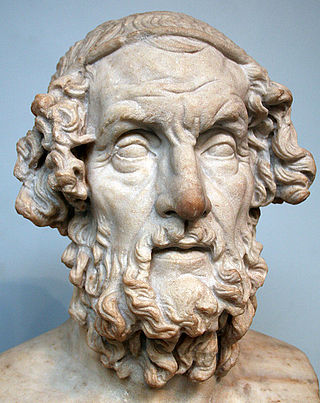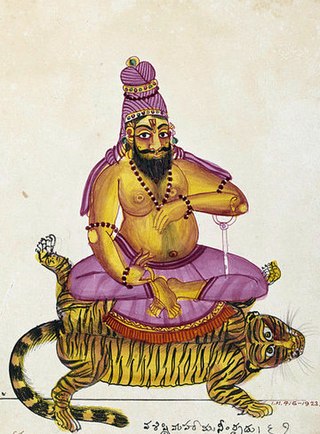Related Research Articles

Ares is the Greek god of war and courage. He is one of the Twelve Olympians, and the son of Zeus and Hera. The Greeks were ambivalent towards him. He embodies the physical valor necessary for success in war but can also personify sheer brutality and bloodlust, in contrast to his sister, the armored Athena, whose martial functions include military strategy and generalship. An association with Ares endows places, objects, and other deities with a savage, dangerous, or militarized quality.

The Battle of Pharsalus was the decisive battle of Caesar's Civil War fought on 9 August 48 BC near Pharsalus in Central Greece. Julius Caesar and his allies formed up opposite the army of the Roman Republic under the command of Pompey. Pompey had the backing of a majority of Roman senators and his army significantly outnumbered the veteran Caesarian legions.

Homer was a Greek poet who is credited as the author of the Iliad and the Odyssey, two epic poems that are foundational works of ancient Greek literature. Homer is considered one of the most revered and influential authors in history.

Imhotep was an Egyptian chancellor to the Pharaoh Djoser, possible architect of Djoser's step pyramid, and high priest of the sun god Ra at Heliopolis. Very little is known of Imhotep as a historical figure, but in the 3,000 years following his death, he was gradually glorified and deified.

Arachne is the protagonist of a tale in Greek mythology known primarily from the version told by the Roman poet Ovid (43 BCE–17 CE), which is the earliest extant source for the story. In Book Six of his epic poem Metamorphoses, Ovid recounts how the talented mortal Arachne challenged the goddess Athena to a weaving contest. When Athena could find no flaws in the tapestry Arachne had woven for the contest, the goddess became enraged and beat the girl with her shuttle. After Arachne hanged herself out of shame, she was transformed into a spider. The myth both provides an aetiology of spiders' web-spinning abilities and was a cautionary tale about hubris.

The Hindu Kush is an 800-kilometre-long (500 mi) mountain range in Central and South Asia to the west of the Himalayas. It stretches from central and eastern Afghanistan into northwestern Pakistan and far southeastern Tajikistan. The range forms the western section of the Hindu Kush Himalayan Region (HKH); to the north, near its northeastern end, the Hindu Kush buttresses the Pamir Mountains near the point where the borders of China, Pakistan and Afghanistan meet, after which it runs southwest through Pakistan and into Afghanistan near their border.

There are several characters named Amphion in Greek mythology:

In Greek mythology, Sisyphus or Sisyphos was the founder and king of Ephyra. Hades punished him for cheating death twice by forcing him to roll an immense boulder up a hill only for it to roll back down every time it neared the top, repeating this action for eternity. Through the classical influence on modern culture, tasks that are both laborious and futile are therefore described as Sisyphean.
Neleus was a mythological king of Pylos. In some accounts, he was also counted as an Argonaut instead of his son, Nestor.

In Greek mythology, Charon or Kharon is a psychopomp, the ferryman of Hades, the Greek underworld. He carries the souls of those who have been given funeral rites across the rivers Acheron and Styx, which separate the worlds of the living and the dead. Archaeology confirms that, in some burials, low-value coins were placed in, on, or near the mouth of the deceased, or next to the cremation urn containing their ashes. This has been taken to confirm that at least some aspects of Charon's mytheme are reflected in some Greek and Roman funeral practices, or else the coins function as a viaticum for the soul's journey. In Virgil's epic poem, Aeneid, the dead who could not pay the fee, and those who had received no funeral rites, had to wander the near shores of the Styx for one hundred years before they were allowed to cross the river.
In Greek mythology, Tyro was an Elean princess who later became Queen of Iolcus.
In Greek mythology, Erebus, or Erebos, is the personification of darkness. In Hesiod's Theogony, he is the offspring of Chaos, and the father of Aether and Hemera (Day) by Nyx (Night); in other Greek cosmogonies, he is the father of Aether, Eros, and Metis, or the first ruler of the gods. In genealogies given by Roman authors, he begets a large progeny of personifications upon Nox, while in an Orphic theogony he is the offspring of Chronos (Time). The name "Erebus" is also used to refer either to the darkness of the Underworld, the Underworld itself, or the region through which souls pass to reach Hades, and can sometimes be used as a synonym for Tartarus or Hades.

The Pictones were a Gallic tribe dwelling south of the Loire river, in the modern departments of Vendée, Deux-Sèvres and Vienne, during the Iron Age and Roman period.
Philodemus of Gadara was an Epicurean philosopher and poet. He studied under Zeno of Sidon in Athens, before moving to Rome, and then to Herculaneum. He was once known chiefly for his poetry preserved in the Greek Anthology, but since the 18th century, many writings of his have been discovered among the charred papyrus rolls at the Villa of the Papyri at Herculaneum. The task of excavating and deciphering these rolls is difficult, and work continues to this day. The works of Philodemus so far discovered include writings on ethics, theology, rhetoric, music, poetry, and the history of various philosophical schools. Ethel Ross Barker suggested in 1908 that he was owner of the Villa of the Papyri Library.

Vasishtha is one of the oldest and most revered Vedic rishis or sages, and one of the Saptarishis. Vasishtha is credited as the chief author of Mandala 7 of the Rigveda. Vasishtha and his family are mentioned in Rigvedic verse 10.167.4, other Rigvedic mandalas and in many Vedic texts. His ideas have been influential and he was called the first sage of the Vedanta school of Hindu philosophy by Adi Shankara.
God is monotheistic in the Abrahamic religions. The three major monotheistic religions of Judaism, Christianity, and Islam, alongside the Baháʼí Faith, Samaritanism, Druze, and Rastafari, are all regarded as Abrahamic religions due to their shared worship of the God that these traditions claim revealed himself to Abraham. Abrahamic religions share the same distinguishing features:
Simon Hornblower, FBA is an English classicist and academic. He was Professor of Classics and Ancient History in the University of Oxford and, before retiring, was most recently a senior research fellow at All Souls College, Oxford.

Enipeus Vallis is a valley in the northern hemisphere of the planet Mars. It is centered at lat. 37°N, long. 267°E in the Arcadia quadrangle (MC-3) between the large volcano Alba Mons and the Tempe Terra plateau. The valley follows a gently sinuous, north-south path for a distance of about 357 km (222 mi). It is likely an ancient watercourse that formed during the early Hesperian period, around 3.7 billion years ago.
In Nonnus's fifth-century AD epic poem the Dionysiaca, Pyrrhus is a minor figure who was punished by the goddess Rhea for his assault of her. His short story is only mentioned in passing.
References
- ↑ Grant, Michael (2002). "Tyro". Who's who in classical mythology. London: Routledge. p. 534. ISBN 978-1-84972-010-6. OCLC 436844033.
- ↑ Rose, Herbert Jennings (2012). "Enipeus (Ἐνιπεύς)". The Oxford Classical Dictionary (Fourth ed.). Oxford. ISBN 978-0-19-954556-8. OCLC 779530090.
{{cite encyclopedia}}: CS1 maint: location missing publisher (link) - ↑ Finkelberg, Margalit, ed. (6 January 2012). "Enipeus". The Homer Encyclopedia. Oxford, UK: Blackwell Publishing Ltd. doi:10.1002/9781444350302. ISBN 978-1-4051-7768-9.
- ↑ Kramolisch, Herwig; Lienau, Cay (2002–2010). "Enipeus". Brill's New Pauly : encyclopaedia of the ancient world. Antiquity. Leiden: Brill. ISBN 90-04-12258-3. OCLC 54952013.